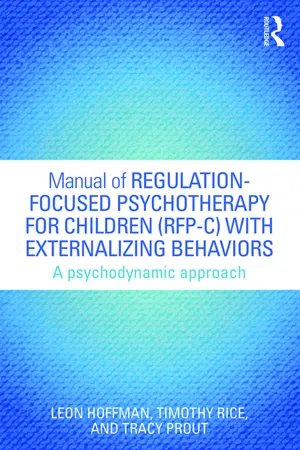
Manual of Regulation-Focused Psychotherapy for Children (RFP-C) with Externalizing Behaviors
A Psychodynamic Approach
- 236 pages
- English
- ePUB (mobile friendly)
- Available on iOS & Android
Manual of Regulation-Focused Psychotherapy for Children (RFP-C) with Externalizing Behaviors
A Psychodynamic Approach
About This Book
Manual of Regulation-Focused Psychotherapy for Children (RFP-C) with Externalizing Behaviors: A Psychodynamic Approach offers a new, short term psychotherapeutic approach to working dynamically with children who suffer from irritability, oppositional defiance and disruptiveness. RFP-C enables clinicians to help by addressing and detailing how the child's externalizing behaviors have meaning which they can convey to the child. Using clinical examples throughout, Hoffman, Rice and Prout demonstrate that in many dysregulated children, RFP-C can:
- Achieve symptomatic improvement and developmental maturation as a result of gains in the ability to tolerate and metabolize painful emotions, by addressing the crucial underlying emotional component.
-
- Diminish the child's use of aggression as the main coping device by allowing painful emotions to be mastered more effectively.
-
- Help to systematically address avoidance mechanisms, talking to the child about how their disruptive behavior helps them avoid painful emotions.
-
- Facilitate development of an awareness that painful emotions do not have to be so vigorously warded off, allowing the child to reach this implicit awareness within the relationship with the clinician, which can then be expanded to life situations at home and at school.
-
This handbook is the first to provide a manualized, short-term dynamic approach to the externalizing behaviors of childhood, offering organizing framework and detailed descriptions of the processes involved in RFP-C. Supplying clinicians with a systematic individual psychotherapy as an alternative or complement to PMT, CBT and psychotropic medication, it also shifts focus away from simply helping parents manage their children's misbehaviors. Significantly, the approach shows that clinical work with these children is compatible with understanding the children's brain functioning, and posits that contemporary affect-oriented conceptualizations of defense mechanisms are theoretically similar to the neuroscience construct of implicit emotion regulation, promoting an interface between psychodynamics and contemporary academic psychiatry and psychology.
Manual of Regulation-Focused Psychotherapy for Children (RFP-C) with Externalizing Behaviors: A Psychodynamic Approach is a comprehensive tool capable of application at all levels of professional training, offering a new approach for psychoanalysts, child and adolescent counselors, psychotherapists and mental health clinicians in fields including social work, psychology and psychiatry.
Frequently asked questions
Information
Section 1 Introduction and theoretical background
1 Introduction Rationale for regulation-focused psychotherapy for children with externalizing behaviors (RFP-C)
The man who first flung a word of abuse at his enemy instead of a spear was the founder of civilization. Thus words are substitutes for deeds.Sigmund Freud, 1893
The nature of externalizing behaviors
Clinical vignette
Definition of emotion regulation
Definition of defense mechanism
Lessons from a moment of therapeutic failure
“If you just stopped it and shape up and act like other kids, all will be OK.”
Countertransference
Table of contents
- Cover Page
- Half Title Page
- Series
- Series
- Series
- Title Page
- Copyright Page
- Dedication
- Contents
- Foreword
- SECTION 1 Introduction and theoretical background
- SECTION 2 Practice manual
- Appendix A
- Appendix B
- Appendix C
- Index